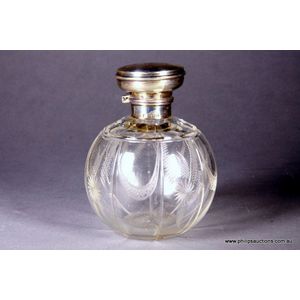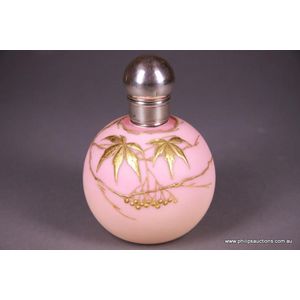Gilded Burmese Glass and Silver Topped Bottle
You must be a subscriber, and be logged in to view price and dealer details.
Subscribe Now to view actual auction price for this item
When you subscribe, you have the option of setting the currency in which to display prices to $Au, $US, $NZ or Stg.
- Art Nouveau Period - The Art Nouveau period was a cultural movement that emerged in the late 19th century, and was characterized by its emphasis on natural forms, flowing lines, and a decorative, ornamental style. Art Nouveau was a reaction against the ornate and heavily stylized designs of the previous era, and sought to create a new, more organic aesthetic.
Art Nouveau was characterized by its use of sinuous, curving lines, as well as a focus on natural elements such as flowers, vines, and other organic shapes. Art Nouveau designers sought to create a total work of art, in which every element of a building or object was designed to be harmonious with the overall design.
Some of the most iconic examples of Art Nouveau design include the Paris Metro entrances designed by Hector Guimard, the works of the artist Alphonse Mucha, and the architecture of Victor Horta in Brussels.
The Art Nouveau period was at its peak between 1890 and 1910, but began to decline in popularity by the start of World War I. However, Art Nouveau remains an important influence on design and art to this day, and continues to be celebrated for its emphasis on natural forms and decorative style. - Cased Glass - Cased glass is a type of glassware that is made by sandwiching a layer of one colour of glass between two layers of another colour of glass. This technique is also known as "slip-casting" and "slip-decorated" or "overlay" glass. The process creates a decorative effect by contrasting the colours of the outer layers with the inner layer. The outer layers can be clear, opaque or coloured and the inner layer can be a different colour, or it can be left clear to create a more subtle effect.
The technique was first developed in the 19th century, primarily in Europe, and it was used to produce a wide range of decorative glassware such as vases, bowls, and bottles. Cased glass was particularly popular during the Art Nouveau period, when many glassmakers, including Loetz, Galle, Steuben and Tiffay began to experiment with different colours and designs to create unique and striking pieces of glassware. - Gilding - Gilding is a method of ornamentation whereby a thin sheet of gold metal is applied to items made of wood, leather, ceramics, glass and silver for decorative purposes.
For furniture including mirrors, the sheet of gold is usually applied over a coating of gesso. Gesso is a mixture of plaster of Paris and gypsum mixed with water and then applied to the carved wooden frames of mirrors and picture frames as a base for applying the gold leaf. After numerous coats of gesso have been applied, allowed to dry and then sanded a coat of "bole", a usually red coloured mixture of clay and glue is brushed on and allowed to dry, after which the gold leaf is applied. Over time parts of the gilding will rub off so the base colour can be seen. In water gilding, this was generally a blue colour, while in oil gilding, the under layer was often yellow. In Victorian times, gilders frequently used red as a pigment beneath the gold leaf.
Metal was often gilded by a process known as fire gilding. Gold mixed with mercury was applied and heated, causing the mercury to evaporate, the long-term effect of which was to kill or disable the craftsman or woman from mercury poisoning. The pursuit of beauty has claimed many victims, not the least of which were the artists who made those pieces so highly sought after today. - Circa - A Latin term meaning 'about', often used in the antique trade to give an approximate date for the piece, usually considered to be five years on either side of the circa year. Thus, circa 1900 means the piece was made about 1900, probably between 1895 and 1905. The expression is sometimes abbreviated to c.1900.
This item has been included into following indexes:
Visually similar items

A Thomas Webb Burmese glass and silver scent bottle. 1885 London, with partial maker's mark H? over Whw, the globular satin glass in an unusual colourway of pale blue to peach to yellow decorated in the Aesthetic manner by Jules Barbe with trailing prunus

A Uranium glass and sterling silver perfume bottle. 1887; Birmingham, with marker's mark for Thomas Webb. The spherical bottle in lemon opaque glass, decorated with gold paste in the distinctive manner of Jules Barbe with exquisite japonaiserie, trails of

A sterling silver topped perfume bottle, 1918 Birmingham, with maker's mark for Charles S green & Co, the elegant spherical bottle with lobed sections alternately decorated with etched swags and fern motifs, slice cuts to the collar, with a silver compress

A Victorian sterling silver topped perfume bottle, 1886 London, with rubbed maker's mark J?, the globular bottle with a spiral rib design, the alternate ribs with cross hatching, and having a hinged and unadorned spherical lid, with the original glass stop
